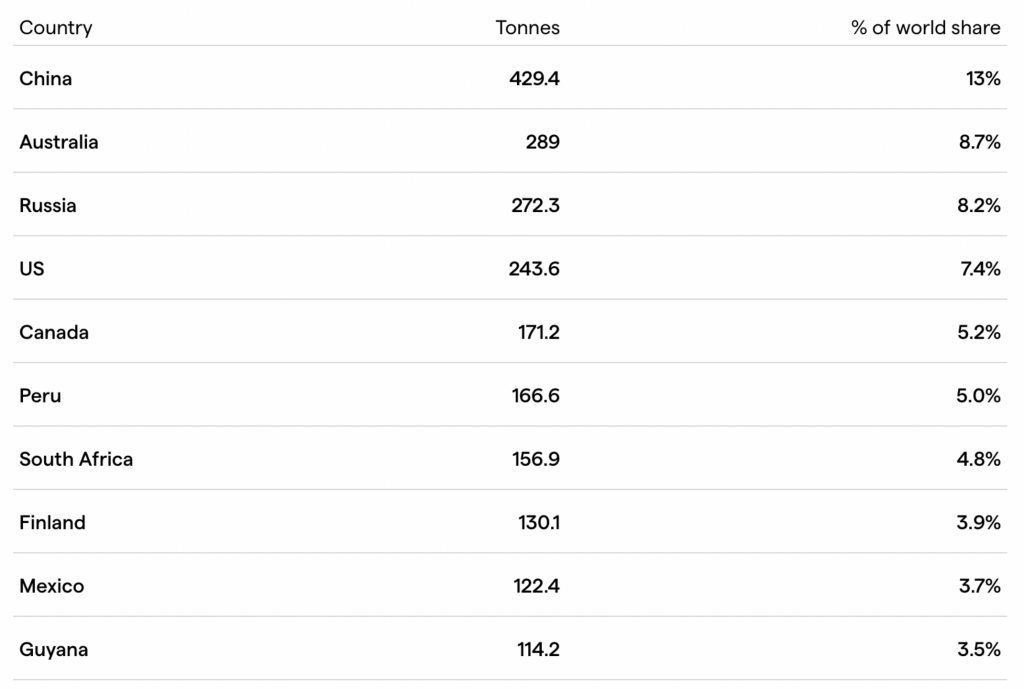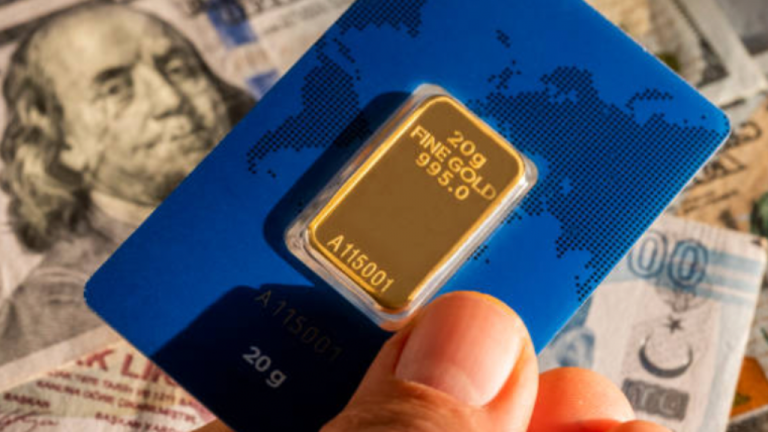Gold is relatively dull and worthless compared to other metals, yet it commands sky-high prices. Why is gold so valuable? We examine the uses of gold and the factors that affect its price.
Since its discovery in Lydia during the reign of King Croesus in 550 B.C., gold has had a unique position among humans and has been a source of value. Civilizations have connected gold with virtues such as immortality and enlightenment. Contemporary culture continues to view it as a sign of perfection, whether by vying for a gold medal or adhering to the ‘golden rule.’ It has been bestowed upon gods, spawned fabled golden towns such as El Dorado sparked actual gold rushes from Canada to South Africa. The metal has been the main driver behind the ups and downs of empires, sparked conflicts that left lifelong wounds, and been an integral part of people’s national identities, such as the Ghanaians and Mozambicans, whose flags incorporate gold as a sign of their mining richness.
Table of Contents
Why Is Gold Valuable?
Facts about Gold and Gold’s Properties
Gold, represented by the chemical symbol Au, is found in mineral veins and alluvial deposits worldwide and is frequently a byproduct of copper and lead (although there are many large mines primarily producing gold). A single one-ounce nugget is more challenging to discover than a five-carat diamond.
Methods for Trading Precious Metals
Gold, which is soft to the touch and gratifying in weight, is distinguished from other metals primarily by its durability and indestructibility. It is chemically inert, which means it is anti-corrosive and durable enough to remain unaltered for thousands of years.
Gold’s everlasting properties need extraterrestrial forces to produce. Theorists think that none of the gold that has ever been retrieved was created on Earth by exploding supernovae or neutron star collisions.
It has excellent thermal and electrical conductivity. It is ductile, which means it can be stretched without breaking, and malleable, allowing it to be rolled out into thin sheets without shattering. One gram of gold may be hammered into a one-meter-wide sheet or drawn into a 165-meter-long wire.
Due to gold’s weakness is frequently alloyed with harder metals such as silver or copper to increase its strength. Gold’s purity is measured in carats, with 24 carats indicating 100 percent pure gold and 18 carats being an alloy with silver comprising 750 parts gold per thousand.
So why is gold valuable?
Throughout millennia, the perceived worth of gold has become embedded in the collective consciousness. The significance of gold in creating the world’s first coins provided the precious metal a long-lasting function, allowing it to serve as the backbone of the world’s currency markets until only 50 years ago.
Precious metals were ideal for the first payment systems, which required tangible units that could be transferred between dealers and merchants. This meant that, in principle, products could be traded without the requirement for immediate delivery and served as a mutually-recognized, directly equivalent unit of exchange.
Discover the Ways to Invest in Gold
Gold and silver were rapidly adopted as the preferred metals for nations seeking to establish money. Due to their malleability and low melting point, they were perfect for coinage. Gold’s distinctive gold and sheen, along with the fact that it does not tarnish, offered it a distinct advantage over other metals. And its rarity instilled trust in its ability to maintain its worth, as no one could attempt to discount it as a currency due to the difficulties of extracting it.
Thus, the world’s initial currencies were backed by gold, a practice that remarkably persisted for millennia. In the 1930s, virtually all nations ceased pegging their currencies to the quantity of gold they had stored in vaults, except the United States, which kept the dollar set at $35 per ounce for four more decades. The dollar remained tied to the price of gold until 1971. However, because most currencies were also pegged to the dollar, gold virtually preserved its position as the foundation of the global foreign exchange market until that time.
The decision to cease backing currencies with gold was essential. The output of gold and the quantity of gold owned by each government did not accurately reflect the state of national economies, which eventually restrained F.X. markets.
How Does Foreign Exchange Work?
Today, gold performs a different role. Even though technological advancements have created new applications for gold as a metal rather than a monetary instrument, gold continues to play a role in foreign exchange and financial markets. Because the gold does not require the backing or assurances of a bank, government, or anybody else, investors view the metal as a haven asset that can maintain its value when other assets fail. Central banks also hold it as a reserve currency or globally recognized asset that may be utilized in times of crisis. Not that long ago, Vietnam required all home purchases to be paid for in gold due to the volatility of the Vietnamese Dong.
Its application in jewelry, technology, and financial markets generates several strands of demand for gold, which contributes to its support during commodity and economic cycles.
Why is Gold More Valuable Than Copper and Silver?
Silver has significantly more industrial applications than gold, copper is simpler to obtain, and a better conductor of electricity and platinum possesses robust properties and is similarly challenging to locate. Why does gold command a higher price than these other metals?
What Is the Potential in Trading Gold vs. Silver?
Surprisingly, gold’s high value is because it is chemically tedious and impractical compared to other metals. All three will tarnish to some degree over time, in contrast to gold, and it is these properties make gold more valuable than other metals. Unlike other commodities, they also alter the dynamics of supply and demand on the gold market. In contrast to metals such as copper, which are produced and consumed, every gold ever generated remains.
How Much Gold Does the World Contain?
According to the World Gold Council – an international trade organization whose members include some of the world’s largest miners. For Example, Agnico Eagle, AngloGold Ashanti, Barrick Gold, Newcrest Mining, and Newmont Mining – slightly more than 190,000 tonnes of gold have been mined throughout history. This translates to more than 6 billion ounces of gold, which may seem like a lot but is still less than one ounce of gold per person. Notably, since 1950, nearly two-thirds of this gold has been extracted.
Newmont will purchase Goldcorp for $10 billion.
Due to its indestructibility, practically all of the gold ever produced is still in circulation today, whether in the shape of a gold bar, a crown, or a computer chip. Further illustrating the metal’s rarity, if all the gold ever mined were melted down, it would fit into a cube of 21 meters on a side, or it would fill slightly over three Olympic-sized swimming pools.
Global production adds between 2,500 and 3,000 tonnes of gold to current resources every year. The metal is widespread and geographically diversified, although the top 10 nations account for over two-thirds of the world’s yearly gold production:

However, new gold production has generally been insufficient to meet demand. About 75 percent of the world’s gold supply is created annually, with the remaining 25 percent coming through recycling. The World Gold Council believes that 90% of recycled gold comes from jewelry, with the remaining 10% coming from technology uses such as electrical or medical devices. Recycling is also crucial to the gold market since it is the most responsive to price fluctuations. While locating a new source of gold and constructing a mine might take more than a decade, individuals seeking to capitalize on a price increase or acute supply shortage can recycle or sell current supplies fast.
It is uncertain how much gold remains on the Earth, although both grades and output have declined. The U.S. Geological Survey estimates that just 57,000 tonnes are left to be mined, which is negligible compared to the amount already removed. Significantly, the quantity of gold left in the ground differs from the amount judged economically and viably extractable. Higher gold prices allow for more expensive extraction, while lower prices indicate more gold might be left in the ground since it cannot be extracted profitably. New approaches and technologies can alter the economics of gold reserves. In addition, fresh discoveries continue to be produced, contributing to the possibility of future supply in the longer term.
The world’s miners may venture out to sea searching for fresh gold deposits. The cost would be exorbitant, and estimates of gold in the world’s oceans range from 15,000 to over 8 million tonnes.
Gold’s Applications: What is Gold Used for?
There are four major markets for gold: on the one hand, it is used to make jewelry and as a component in technical applications; on the other hand, it is kept by central banks and exchanged by investors.
Approximately half of all gold is used to create jewelry. India and China account for as much as fifty percent of the worldwide demand for gold jewelry.
Less than 10 percent of the population uses technology. Gold is a conductivity metal in ordinary gadgets such as smartphones and tablets (each smartphone is estimated to contain between $1.00 and $1.50 worth of gold). However, it is also a critical component in high-end applications. For instance, the mirrors of NASA’s new James Webb Space Telescope are coated with an ultrathin layer of gold to use its reflecting properties. The quantity of gold utilized in technology is expected to increase as additional uses are discovered, such as in innovative fields such as medicine.
In 2018, 12 percent of the total demand for gold came from central banks. Long-term trends indicate that central banks sold more gold than they purchased between 1987 and 2009 but have increased their gold holdings after the financial crisis when gold’s position as a safe-haven asset increased. The Fed’s gold reserves are presently valued at more than $310 billion.
In the same period, investment markets accounted for 27% of total gold demand. This reflects the lowest share of the entire order since 2015 and is far lower than the levels observed during the 2008-2012 financial crisis when up to 40 percent of all gold demand came from trading. As financial markets began to recover in 2013, the share dropped to 18 percent, rose to its most recent record of 37 percent in 2016, and dipped to 30 percent in 2017.
What Influences the Price of Gold?
Numerous variables influence the gold price; however many of them are interconnected:
Gold as a safe-haven asset: Gold is not as susceptible to market or political variables as foreign currencies or other commodities such as oil. Many feel that gold retains its value over more extended periods, making it attractive to investors seeking a haven when stock, financial, or commodities markets are tumultuous. Generally, uncertain times encourage a higher gold price.
The effect of geopolitics on the gold prices: Uncertain investors might be frightened by escalating trade tensions, escalating war, and even political changes if they do not know how these factors would affect their investments. Gold is the primary benefactor of any escalating geopolitical tensions as a haven.
The effect of the USD on the price of gold: Although the dollar is no longer connected to the cost of gold, there is a connection between the two. As the worldwide reserve currency, gold trades predominantly in dollars, and a weaker dollar generally leads to higher gold prices and vice versa.
As a result of inflation typically causing central banks to increase the money supply as a countermeasure, the price of gold tends to increase during higher inflation periods and decrease during deflationary periods.
The effect of interest rates on the price of gold is that lower interest rates are more favorable for gold prices than higher interest rates. Investors may obtain better returns from other alternatives (such as a savings account) when interest rates are higher, diverting capital away from the gold market. However, when interest rates are low, the attraction of gold increases since yields elsewhere are likewise low.
The effect of supply and demand on the price of gold: Because gold is not used, its supply-demand dynamics are not as significant as those of other commodities. Trends indicate that industries seeking to employ gold as a metal, such as in jewelry or technology, attempt to increase their gold purchases when prices fall and decrease them when prices rise. These swings in supply and demand cause price fluctuations in gold.
The gold price is also influenced by economic statistics and monetary policy, which have a part in its rise or fall. It is also essential to understand that the connection between gold prices and these factors is not a given: prices and interest rates, for example, only move in the same direction approximately half the time. This is because the price is influenced by various factors, all of which must be considered by investors.
Final Thoughts
Gold is one of the primary destinations for investors seeking security in times of uncertainty and volatility, serving as an insurance policy to diversify and protect portfolios against widespread market declines.




